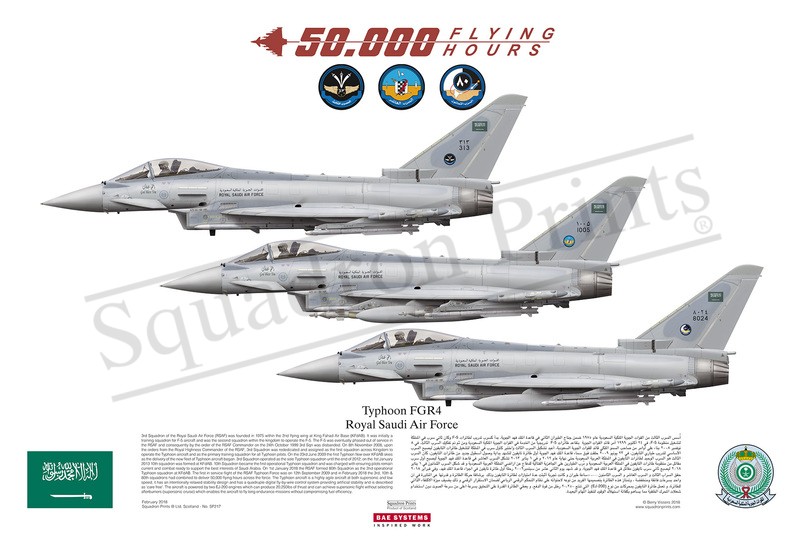#SP217 Typhoon FGR4

Purchased products will not feature the Squadron Prints watermark
Description
Squadron Prints Lithograph No. SP217 - Typhoon FGR4, Royal Saudi Air Force.
3rd Squadron of the Royal Saudi Air Force (RSAF) was founded in 1975 within the 2nd flying wing at King Fahad Air Base (KFdAB). It was initially a training squadron for F-5 aircraft and was the second squadron within the kingdom to operate the F-5. The F-5 was eventually phased out of service in the RSAF and consequently by the order of the RSAF Commander on the 24th October 1999 3rd Sqn was disbanded. On 8th November 2008, upon the orders from the Royal Highness Commander of the RSAF, 3rd Squadron was rededicated and assigned as the first squadron across Kingdom to operate the Typhoon aircraft and as the primary training squadron for all Typhoon pilots. On the 23rd June 2009 the first Typhoon flew over KFdAB skies as the delivery of the new fleet of Typhoon aircraft began. 3rd Squadron operated as the sole Typhoon squadron until the end of 2012, on the 1st January 2013 10th squadron was formed at KFdAB. 10th Squadron became the first operational Typhoon squadron and was charged with ensuring pilots remain current and combat ready to support the best interests of Saudi Arabia. On 1st January 2018 the RSAF formed 80th Squadron as the 2nd operational Typhoon squadron at KFdAB. The first in service flight of the RSAF Typhoon Force was on 12th September 2009 and in February 2018 the 3rd, 10th & 80th squadrons had combined to deliver 50,000 flying hours across the force. The Typhoon aircraft is a highly agile aircraft at both supersonic and low speed, it has an intentionally relaxed stability design and has a quadruple digital fly-by-wire control system providing artificial stability and is described as ‘care free’. The aircraft is powered by two EJ-200 engines which can produce 20,250lbs of thrust and can achieve supersonic flight without selecting afterburners (supersonic cruise) which enables the aircraft to fly long endurance missions without compromising fuel efficiency.
